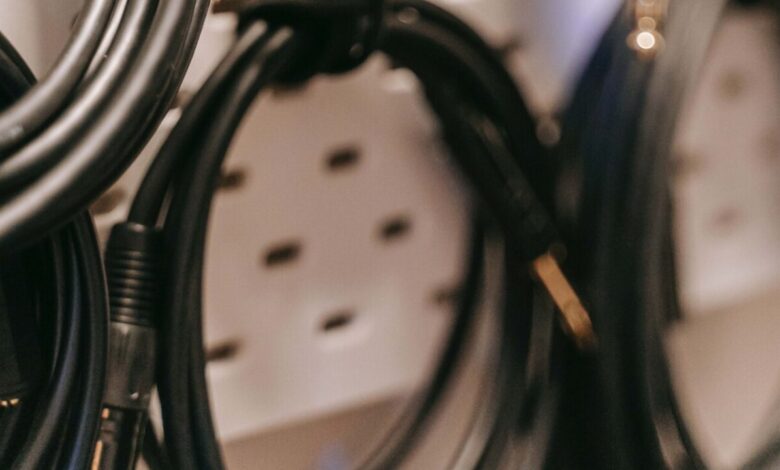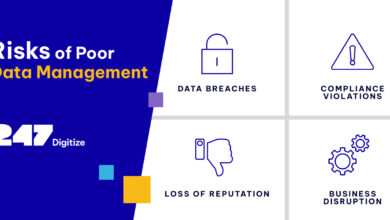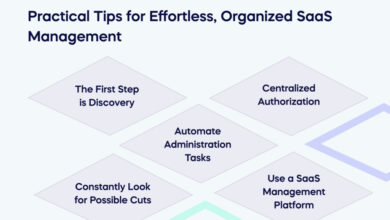
5 Reasons Structured Cabling Boosts IT Security
5 Reasons Structured Cabling Networks are critical for IT security management: In today’s hyper-connected world, robust network security is paramount. But how much thought do you give to the physical infrastructure underpinning your digital defenses? The answer, surprisingly, is a lot! A well-designed structured cabling system isn’t just about neat wires; it’s a fundamental cornerstone of a strong security posture.
This post delves into five crucial ways structured cabling significantly enhances your IT security, moving beyond the usual discussions of firewalls and antivirus software to explore the often-overlooked physical layer.
From enhanced network segmentation that minimizes attack surfaces to simplified network management for quicker threat response, structured cabling offers a multifaceted approach to bolstering your security. We’ll explore how it aids in data confidentiality, simplifies compliance with industry regulations, and future-proofs your security investments. Get ready to see your network infrastructure in a whole new light!
Enhanced Network Security
Structured cabling is more than just neatly organized wires; it’s a foundational element of robust IT security. A well-designed structured cabling system significantly improves network security by providing a framework for implementing various security measures, ultimately reducing vulnerabilities and protecting sensitive data. This goes beyond simply connecting devices; it’s about building a secure network infrastructure from the ground up.
Structured cabling dramatically enhances network segmentation. By logically separating network segments through physical cabling organization, you limit the impact of a security breach. If one segment is compromised, the damage is contained, preventing attackers from easily traversing the entire network. This is achieved by using separate cables and switches for different network segments, like separating guest Wi-Fi from the internal network.
This approach significantly reduces the attack surface, the portion of a system exposed to potential attacks.
Physical Security Measures and Their Role in IT Security
Physical security is often overlooked, but it’s a crucial component of a comprehensive security strategy. Structured cabling facilitates physical security measures in several ways. For example, cable pathways can be secured within locked cabinets or conduits, preventing unauthorized access to network connections and equipment. This prevents tampering and unauthorized tapping into network cables. Furthermore, the organized nature of structured cabling makes it easier to monitor and manage physical access to network infrastructure, aiding in identifying and preventing potential threats.
Imagine a data center with clearly labeled and organized cables – identifying a potential problem or unauthorized connection becomes significantly easier than in a tangled mess of wires.
Network Access Control Lists (ACLs) and Firewalls in Structured Cabling
Structured cabling plays a vital role in the effective implementation of ACLs and firewalls. By physically separating network segments, structured cabling allows for granular control over network access. ACLs can be implemented on routers and switches to restrict access to specific network segments based on IP addresses, MAC addresses, or other criteria. This is particularly effective when combined with firewalls placed strategically within the network architecture, which is greatly simplified and made more efficient by a well-organized structured cabling system.
The clear demarcation of network segments facilitated by structured cabling makes it simpler to manage and enforce these security policies.
Comparison of Security Vulnerabilities
| Vulnerability | Unstructured Cabling Impact | Structured Cabling Impact | Mitigation Strategies |
|---|---|---|---|
| Unauthorized Access | Easy access to cables; difficult to track and secure connections, leading to potential tapping or tampering. | Difficult access; clear pathways and labeling make monitoring and securing easier. | Locked cabinets, cable conduits, access control systems, regular physical security audits. |
| Eavesdropping | High risk due to disorganized cables; easier to intercept data signals. | Lower risk due to organized and shielded cabling; easier to identify and secure vulnerable points. | Shielded cables, encryption, regular network monitoring for anomalies. |
| Network Segmentation Failure | Difficult to segment networks effectively; compromised segment can easily spread to others. | Easier to segment networks effectively; containment of breaches is improved. | Logical network segmentation, firewalls, intrusion detection/prevention systems. |
| Maintenance Difficulties | Troubleshooting and maintenance are extremely time-consuming and complex. | Easier and faster troubleshooting and maintenance due to organized cabling. | Clear documentation, standardized cabling practices, regular maintenance schedules. |
Simplified Network Management and Monitoring

Structured cabling is the backbone of any robust IT infrastructure, and its impact extends far beyond simple connectivity. A well-designed structured cabling system significantly simplifies network management and monitoring, leading to improved efficiency and enhanced security. The standardization and organization inherent in structured cabling make troubleshooting and maintenance far less cumbersome than in haphazardly wired networks.The predictable nature of structured cabling allows for easier identification of network problems.
Tracing cables, locating faulty components, and isolating issues becomes a streamlined process, leading to faster resolution times and minimized downtime. This is especially crucial in security contexts, where rapid response to potential breaches is paramount. For instance, a quickly identified cable fault affecting a security camera network can prevent a significant security lapse.
Troubleshooting and Resolution of Network Issues
Standardized cabling, with its clearly labeled and documented pathways, simplifies troubleshooting. When a network issue arises, technicians can quickly pinpoint the affected segment, whether it’s a specific patch panel, cable run, or device. This structured approach dramatically reduces the time spent searching for the problem’s source, allowing for faster repairs and reduced disruption to network services. Color-coding, clear labeling, and detailed documentation are essential for effective troubleshooting within a structured cabling environment.
Imagine trying to find a faulty wire in a jumble of cables versus a neatly organized rack—the difference is night and day.
Network Monitoring and Logging Improvements
Structured cabling directly improves network monitoring capabilities. With a clearly defined and documented network topology, monitoring tools can accurately track data flow and identify potential bottlenecks or security threats. Centralized patch panels provide convenient access points for monitoring equipment, simplifying the deployment and management of network monitoring systems. Moreover, the standardized cabling facilitates the implementation of network monitoring software that can automatically detect and log network activity, providing valuable data for security analysis and incident response.
So, you’re thinking about IT security and those crucial 5 reasons structured cabling networks are essential? It’s all about control and visibility, right? Well, secure network infrastructure is vital for efficient app development too, which is why I’ve been diving into the world of domino app dev, the low-code and pro-code future , lately. Understanding this helps streamline the deployment of secure applications, which ties back to those 5 reasons a robust, structured cabling network is paramount for overall IT security management.
For example, a monitoring system could detect unusual network traffic patterns on a specific segment, potentially indicating a malicious attack.
Impact of Structured Cabling on Network Performance and Security
The performance of a network is directly tied to its physical infrastructure. Structured cabling, with its high-quality components and standardized design, ensures optimal signal transmission, minimizing signal loss and interference. This improved performance translates directly to enhanced security. Faster data transfer speeds allow for quicker response times to security threats, and reduced signal degradation ensures the integrity of security protocols.
For instance, a high-bandwidth network secured by a structured cabling system can support real-time intrusion detection systems and other security applications without performance degradation.
Implementing a Network Monitoring System
Implementing a network monitoring system within a structured cabling environment is a straightforward process. The structured nature of the cabling makes integration easier and more efficient.
- Network Topology Documentation: Begin by creating a comprehensive, up-to-date diagram of your network topology, including all cables, devices, and connections. This serves as the foundation for your monitoring system.
- Monitoring Tool Selection: Choose a network monitoring tool appropriate for your network size and complexity. Consider factors like scalability, features, and integration capabilities with your existing infrastructure.
- Sensor Placement: Strategically place network monitoring sensors (e.g., network probes, packet sniffers) at key points within your structured cabling system, such as patch panels and critical network segments. This ensures comprehensive coverage.
- System Configuration: Configure the monitoring tool to collect relevant network data, including traffic patterns, device status, and security events. Customize alerts for critical events, such as unusual activity or security breaches.
- Data Analysis and Reporting: Regularly analyze the collected data to identify trends, potential problems, and security threats. Generate reports to track network performance and security posture.
Improved Data Confidentiality and Integrity: 5 Reasons Structured Cabling Networks Are Critical For It Security Management

Structured cabling plays a vital role in bolstering data confidentiality and integrity within a network. Its organized and standardized approach to network infrastructure facilitates the implementation of robust security measures, significantly reducing vulnerabilities and enhancing overall data protection. A well-designed structured cabling system provides the physical and logical foundation for secure data transmission and storage.Structured cabling directly supports encryption and secure data transmission through its ability to easily accommodate fiber optic cables, which are inherently more secure than traditional copper cabling due to their resistance to electromagnetic interference and eavesdropping.
Furthermore, the clear demarcation and labeling within a structured cabling system simplifies the implementation of network segmentation, allowing for the isolation of sensitive data and resources from less critical areas. This physical separation, combined with appropriate network security protocols, creates a layered security approach that is significantly more effective than what can be achieved in an unstructured environment.
Comparison of Data Protection Strategies on Structured and Unstructured Cabling Networks, 5 reasons structured cabling networks are critical for it security management
Implementing data protection strategies, such as encryption and access control lists (ACLs), is far more efficient and reliable on a structured cabling network. In an unstructured network, tracing cables and identifying vulnerabilities is a complex and time-consuming process, making effective security implementation difficult and potentially leaving significant gaps. In contrast, the clear organization and documentation of a structured cabling system allows for precise identification of network segments and devices, enabling targeted security measures.
For example, implementing end-to-end encryption is straightforward when you know exactly which cables connect which devices. This precision minimizes the risk of accidental exposure of sensitive data and greatly simplifies troubleshooting. Unstructured networks often lack this level of control, resulting in a higher likelihood of security breaches.
Physical Security Controls Enabled by Structured Cabling
Structured cabling directly supports enhanced physical security through several key mechanisms. The organized cable management inherent in structured cabling makes it easier to implement physical access controls, such as locking cabinets and restricting access to specific areas of the network infrastructure. This physical limitation significantly reduces the risk of unauthorized access to network equipment and cabling, thereby minimizing the potential for theft or tampering.
Furthermore, the clear labeling and documentation of the cabling system allows for rapid identification of potential points of intrusion, accelerating incident response times and minimizing potential damage. Imagine a scenario where an intruder attempts to tap into a network. In a structured environment, identifying the compromised point is much simpler and faster, limiting the scope and impact of the breach.
Security Protocols Benefiting from a Well-Structured Cabling System
A well-structured cabling system provides a solid foundation for the effective implementation of various security protocols. The clear organization and documentation of the network significantly improve the effectiveness of these protocols.
- Virtual Local Area Networks (VLANs): VLANs rely on logical segmentation of the network, and a structured cabling system makes it easier to physically separate these segments, enhancing security by isolating sensitive data from less critical network segments.
- Network Access Control (NAC): NAC solutions are significantly more effective when combined with a well-structured cabling system. The ability to easily identify and track network devices allows for precise control over network access, preventing unauthorized devices from connecting to the network.
- Intrusion Detection/Prevention Systems (IDS/IPS): The organized nature of structured cabling facilitates the deployment and management of IDS/IPS systems. By providing clear visibility into network traffic flow, these systems can more effectively identify and respond to malicious activity.
- Data Loss Prevention (DLP): DLP solutions rely on monitoring network traffic to identify and prevent sensitive data from leaving the network. A structured cabling system simplifies the process of monitoring network traffic, improving the effectiveness of DLP measures.
Easier Compliance with Security Standards and Regulations

A well-structured cabling system is not just about efficient network connectivity; it’s a cornerstone of robust IT security and a crucial element in achieving and maintaining compliance with industry regulations. The clear documentation and standardized layout inherent in structured cabling significantly simplifies the auditing process and reduces the risk of non-compliance penalties. This directly translates to cost savings and a stronger security posture.Structured cabling provides a clear audit trail, making it easier to demonstrate compliance with various security standards.
This is particularly vital for organizations handling sensitive data, subject to stringent regulations like HIPAA (Health Insurance Portability and Accountability Act) for healthcare or PCI DSS (Payment Card Industry Data Security Standard) for payment processing. The clear labeling and documentation of all cabling components allows auditors to quickly verify that network infrastructure meets the required standards. For instance, HIPAA requires strict controls over the access and transmission of Protected Health Information (PHI).
A well-documented structured cabling system allows for easy verification of network segmentation and access controls, demonstrating compliance with HIPAA’s security rule.
Simplified Documentation and Auditing Processes
A structured cabling system facilitates the creation and maintenance of comprehensive documentation, including cable diagrams, patch panel layouts, and connection details. This readily available documentation is essential for security audits and assessments. During an audit, auditors can quickly review the documentation to verify the network’s physical security, confirming that only authorized personnel have access to critical infrastructure. For example, a clearly documented structured cabling system allows auditors to easily trace the path of data, confirming that sensitive data is not traversing unauthorized or insecure network segments.
The ability to quickly identify and isolate compromised segments is a key advantage. Furthermore, change management processes are significantly improved, as all modifications to the cabling infrastructure are properly documented and auditable. This reduces the risk of accidental or unauthorized changes that could compromise security.
Facilitating Regular Security Audits and Assessments
Regular security audits are essential for identifying vulnerabilities and ensuring ongoing compliance. A structured cabling system greatly simplifies this process. The clear and organized network infrastructure allows auditors to efficiently assess the physical security of the network, identifying potential vulnerabilities such as unsecured cabling, unauthorized connections, or poorly labeled equipment. For instance, a structured cabling system with clearly labeled patch panels and cables makes it easy to verify that only authorized devices are connected to the network.
This helps prevent unauthorized access and data breaches. Furthermore, the detailed documentation associated with a structured cabling system allows for efficient tracking of network changes, making it easier to identify and address any potential security risks introduced by recent modifications. This proactive approach to security management minimizes the impact of potential breaches.
Alignment of Structured Cabling Best Practices and Security Standards
| Security Standard | Relevant Cabling Practice | Compliance Benefit | Potential Risks of Non-Compliance |
|---|---|---|---|
| HIPAA | Clear labeling of all cables and network devices, proper segregation of networks for PHI, secure termination points | Easy verification of network segmentation and access controls, ensuring PHI is protected | Data breaches, non-compliance fines, reputational damage |
| PCI DSS | Use of shielded cabling to prevent eavesdropping, secure cable management to prevent physical tampering, regular cabling audits | Protection of cardholder data, demonstration of compliance with security requirements | Data breaches, fines from payment card companies, loss of customer trust |
| NIST Cybersecurity Framework | Comprehensive documentation of the cabling infrastructure, adherence to industry best practices for cable management, regular maintenance and updates | Improved visibility into the network infrastructure, enhanced ability to detect and respond to security incidents | Increased vulnerability to cyberattacks, difficulty in incident response, reputational damage |
| ISO 27001 | Implementation of a robust change management process for cabling modifications, regular inspections and testing of cabling infrastructure | Improved asset management, enhanced control over access to sensitive data, demonstration of commitment to information security | Non-compliance with information security standards, increased risk of data breaches, reputational damage |
Scalability and Future-Proofing Security Infrastructure
A well-designed structured cabling system is more than just a network backbone; it’s a cornerstone of a robust and adaptable security infrastructure. Its inherent scalability allows organizations to easily expand their network and integrate new security technologies as threats evolve and business needs change, minimizing disruption and maximizing long-term cost-effectiveness. This adaptability is crucial in today’s dynamic threat landscape.The ability to seamlessly incorporate new security devices, such as advanced firewalls, intrusion detection systems, and access control systems, is paramount.
A structured cabling system, with its standardized architecture and clearly defined pathways, simplifies this process considerably. This avoids the chaotic and often insecure “spaghetti wiring” that can plague ad-hoc network deployments, hindering both security and manageability.
Best Practices for Designing a Scalable Structured Cabling Network
Designing a scalable structured cabling network requires careful planning and foresight. Key considerations include utilizing modular components that can be easily added or replaced, employing sufficient capacity to accommodate future growth, and adhering to industry standards like TIA-568. Choosing future-proof cabling technologies like fiber optics, which offer higher bandwidth and longer distances, is also essential. Redundancy, through multiple pathways and backup systems, is vital to ensure continued operation even during disruptions.
Regular audits and assessments of the cabling infrastructure are also crucial to identify potential bottlenecks or vulnerabilities before they become critical issues. Finally, documentation of the entire network, including cable paths, device locations, and connections, is essential for easy troubleshooting and future expansion.
Long-Term Cost Savings Associated with a Robust Structured Cabling Infrastructure
While the initial investment in a robust structured cabling system might seem substantial, the long-term cost savings are significant. The ease of expansion and upgrade reduces downtime and labor costs associated with frequent network reconfigurations. The reduced risk of security breaches minimizes the potential financial losses from data theft or system disruption. Furthermore, the extended lifespan of a well-maintained structured cabling system avoids the need for frequent replacements, leading to further cost savings over time.
Consider the scenario where an organization experiences a significant security incident. A well-planned structured cabling system simplifies the investigation and remediation process, potentially reducing the overall impact of the incident.
Scenario Illustrating the Benefits of a Flexible Structured Cabling System During a Security Incident
A major security incident involving a suspected data breach occurred at Acme Corporation. Their well-structured cabling system allowed security personnel to quickly isolate the affected network segment, limiting the spread of the breach. The clear documentation and standardized cabling facilitated a swift investigation, enabling them to identify the point of intrusion and implement remediation measures efficiently. The pre-existing infrastructure also allowed for the rapid deployment of additional security devices, such as intrusion detection systems and network monitoring tools, to further secure the network and prevent future attacks. The entire process was significantly smoother and faster than it would have been with a haphazardly wired network, minimizing business disruption and financial losses.
Last Recap
So, there you have it – five compelling reasons why structured cabling is not just a nice-to-have, but a critical component of a robust IT security strategy. Investing in a well-planned, properly implemented structured cabling system isn’t just about organized wires; it’s about proactively mitigating risks, streamlining management, and ensuring the long-term security and scalability of your entire network.
It’s an investment in peace of mind, knowing your data and systems are protected by a solid, reliable foundation. Don’t underestimate the power of a well-structured network – it’s the silent guardian of your digital world.
FAQs
What are the common mistakes companies make with their cabling infrastructure that compromise security?
Common mistakes include using inadequate cable types, poor labeling practices, insufficient physical security for cabling closets, and neglecting regular maintenance and audits.
How does structured cabling impact network performance, and how does that relate to security?
Structured cabling improves network performance by reducing signal loss and interference. Faster, more reliable networks are less vulnerable to attacks that exploit slowdowns or latency.
Can structured cabling completely eliminate security risks?
No, structured cabling is a crucial layer of security, but it’s part of a broader strategy. It reduces vulnerabilities but doesn’t eliminate all risks. Firewalls, intrusion detection systems, and other security measures are still essential.
How much does it cost to implement a structured cabling system?
The cost varies greatly depending on the size of the network, the complexity of the design, and the type of cabling used. It’s best to get quotes from several cabling installers.





